Chrysanthemums need to pinch in the vegetative stage, irrigate, fertilize and protect themselves from insects. Plant nutrition is essential for life and good growth. Feeding Chrysanthemum plants will help ensure their continued health and permanent supply of beautiful, rayed flowers. Let’s check out the best fertilizer for Chrysanthemum.
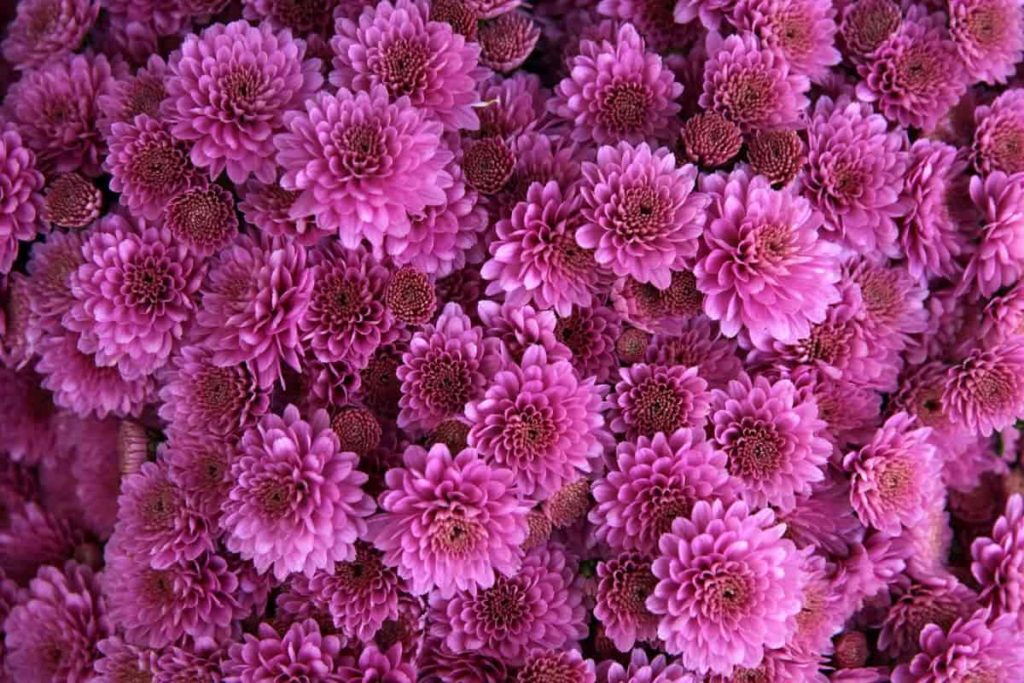
To ensure a healthy and consistent supply of these beautiful lying flowers, your Chrysanthemum plants need to be fed with good plant nutrition. It is essential for their life and healthy growth. You need to feed Chrysanthemum plants before flower buds form, otherwise, they won’t be so productive in the opening. This will promote healthy roots, the growth of buds, and a strong plant. Feed with high nitrogen fertilizer when plants are growing.
Best fertilizer for Chrysanthemum
Compost manure for Chrysanthemum
Good organic manure is obtained from livestock manure as it contains macronutrients and micronutrients with a relatively complete and low C/N ratio. The quality and quantity of Chrysanthemum plants as nitrogen works to accelerate plant growth, stimulate repletion, improve quality, especially protein and become a source of food for bacteria around the plant.
Farmyard manure
Cow dung manure for plants is a perfect fertilizer rich in organic matter that helps in improving air and breaking down compacted soils. The land is plowed 3 to 4 times and 10 to 12 tons per acre of farmyard manure is applied.
Vermicompost
The application of vermicompost facilitates goodness avoids drainage and water-filled conditions.
Homemade fertilizers for Chrysanthemum
Coffee grounds
Used coffee grounds make an effective and fast fertilizer for Chrysanthemum plants. You can just mix coffee grounds in soil.
Castor cake
Castor cake is natural nitrogen fertilizer. Castor cake 50 kg per acre is applied at the time of planting.
Horn dust and Neem cake mixture
You should use this fertilizer only once a season. It is called horn dust and neem-cake (2:1) mixture for 50 grams for 8-inch pot, 100 grams for 12-inch pot, a strength boosting permanent ongoing natural fertilizer. It takes about 2 months to erode its power. Dig at least 6 inches away from the soil around the stem. Don’t just dig the topsoil but dig deep to make a ring to which we will add horn dust.
In case you miss this: Growing Chrysanthemums in Pots from Seeds, Cuttings
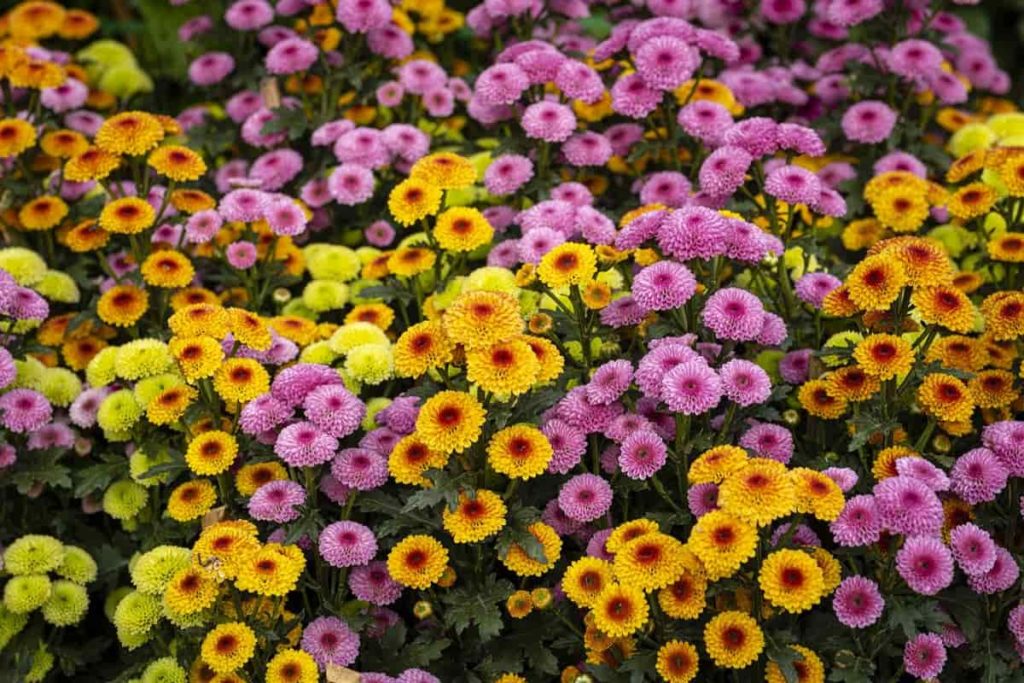
Remove the soil from the dug area and then add a lot of horn dust into the area. Cover the manure with a thick soil pattern. If you don’t have horn dust, mix vermicompost with banana peel dust, use once in just one season, and water well. Continue liquid mustard cake fertilizer every 12 to 15 days. Horn dust is just an extra fertilizer.
Liquid fertilizers for Chrysanthemum
Liquid fertilizer is produced by fermentation. Take about two kilos of fresh cow dung, alternatively compost the farmyard in 10 liters of water. A large container is filled with water and cow dung is put in a muslin cloth and suspended in the water container for two weeks or more. The liquid is then diluted in tea color and kept at 500 ml to 1 liter per pot.
Mustard cake
To make mustard cake liquid fertilizer, have 100 grams of mustard cake for 20 liters of water and keep it for 4 days for fermentation then use it. Add liquid mustard cake fertilizer to the pot or location 20 days after transplant. Place the plant in a place where it can get plenty of sunlight, but the rain never passes in.
Epsom salt
Chrysanthemums benefit from extra magnesium. While Epsom Salts is often included in the growing media, this dose is often spent after several weeks. Mg deficiency appears as interval chlorosis at lower leaves. 56 to 87 grams of Epsom salt mixed with 100 gallons of solution apply every other week. Never apply chelated iron on plants under water stress. The mums also benefit from the extra Epsom salts added to irrigation water. The Epsom provides magnesium, which can help keep the leaves in dark green.
Organic fertilizers for Chrysanthemum
Bone meal
Bone meal fertilizer makes your Chrysanthemum plants a fantastic organic compost to supply vital nutrients like calcium and phosphorus, promoting strong, healthy plants and production. It is water-solving fertilizer that can be applied as a liquid. Its increase in the soil increases nitrogen levels very effectively. Nitrogen levels tend to fluctuate easily in the soil, as many plants are heavy feeders of nitrogen.
In case you miss this: Plants that Grow from Stem Cuttings: List
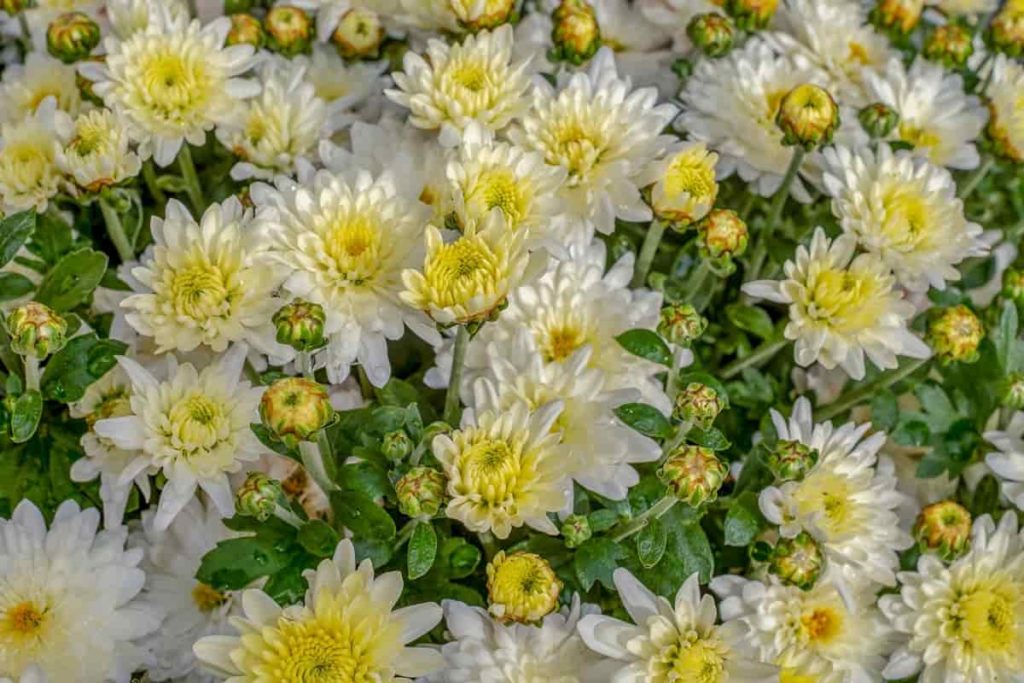
Alfalfa pellets
Alfalfa pellets also act as a slow-release fertilizer that is a great source of nitrogen.
Commercial fertilizers for Chrysanthemum
NPK ratio
You can choose to use a granular application with a formulation of 6-2-4 or 4-2-3 analysis to fertilize your Chrysanthemum plants. And the rate should be 460 grams per 100 square feet of the garden bed.
- Soluble fertilizer is also useful. They are mixed with water in the manufacturer’s instructions and applied to the plant’s root zone. Use a balanced nutritional solution 20-20-20 or 15-15-15 for this method of feeding.
- Time-release feeds have to be applied only once but will release nutrients slowly in about 3 months. If you are applying slow-release food, use 12-6-6 but make sure you can get it quickly that nutrients will be absorbed by mid-summer. Do not feed again until next spring.
- Some farmers prefer high ammonia fertilizers like 20-20-20 during the initial stages of development (first two weeks). The farmers then move around 20-10-20. During cold temperatures or low light levels, farmers who use 20-20-20 on soilless media risk ammonium toxicity as this fertilizer contains nitrogen 75% ammonium and urea. Once the plants are actively growing, 15-15-15 can be rotated in every third of water to help prevent the stretch of plants.
Chrysanthemum fertilizer schedule
Water-soluble fertilizers
Chrysanthemum needs 40 to 120 ppm calcium, 30 to 60 ppm magnesium, and 25 to 75 ppm sulfur regularly. If your water is deficient in these elements, verify that they are supplied by fertilizer as most do not provide significant levels of these three elements.
In case you miss this: Top 15 Fast Growing Medicinal Herbs
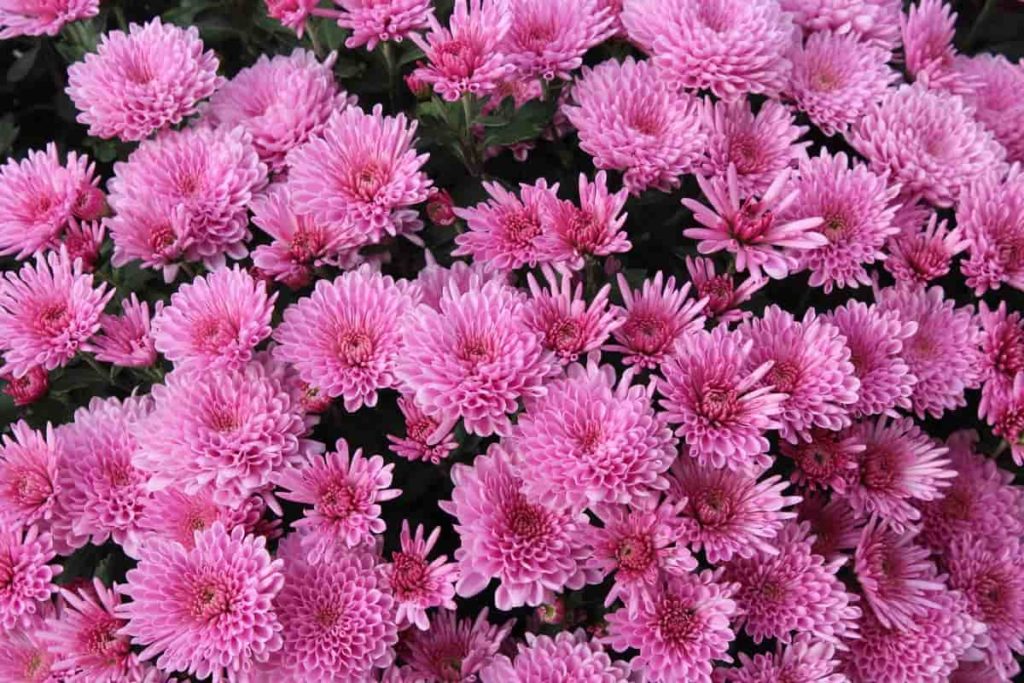
Young plants
The main objective when rooting Chrysanthemum cutting is to avoid nutrient deficiency as it can compromise plant growth and bud formation as well as reduce branches. In addition, it is also important to keep cutting away from withering due to water scarcity as this can also reduce overall growth and branches. It has been recommended that fertilization will start 3 days after sticking to the rate of 100 to 150 ppm nitrogen, which is 2 to 3 times a week.
Vegetative stage
The rate of application of fertilizer is required to be higher for a faster growth rate, so the rate of application of water-soluble fertilizer should be increased to the permanent feed rate of 200 to 300 ppm nitrogen. It is not uncommon for some cultivators to show signs of iron deficiency during this stage.
Flowering stage
Once the flowers start, the Chrysanthemum growth rate slows down. The fertilizer application rate should be reduced to 75 to 125 ppm nitrogen on a permanent feed basis and provided until the mums are sold. Excess salts can burn the Chrysanthemums roots, causing plant damage.
Control release fertilizers / granular fertilizers
Regular application of water-solving fertilizer is the most effective way to maintain proper fertility levels. The water-solving program gives the farmer control over the fertility of plants. Shortly after planting, the controlled release has become a popular and successful way to fertilize the Chrysanthemum of the top-dressing garden using fertilizers. Farmers can choose the best rate based on fertilizer type, increasing medium, irrigation practices, and pot size. Many farmers use the type of 3 to 4 months release in association with liquid food.
In case you miss this: Top 18 Flowers to Grow on the Terrace
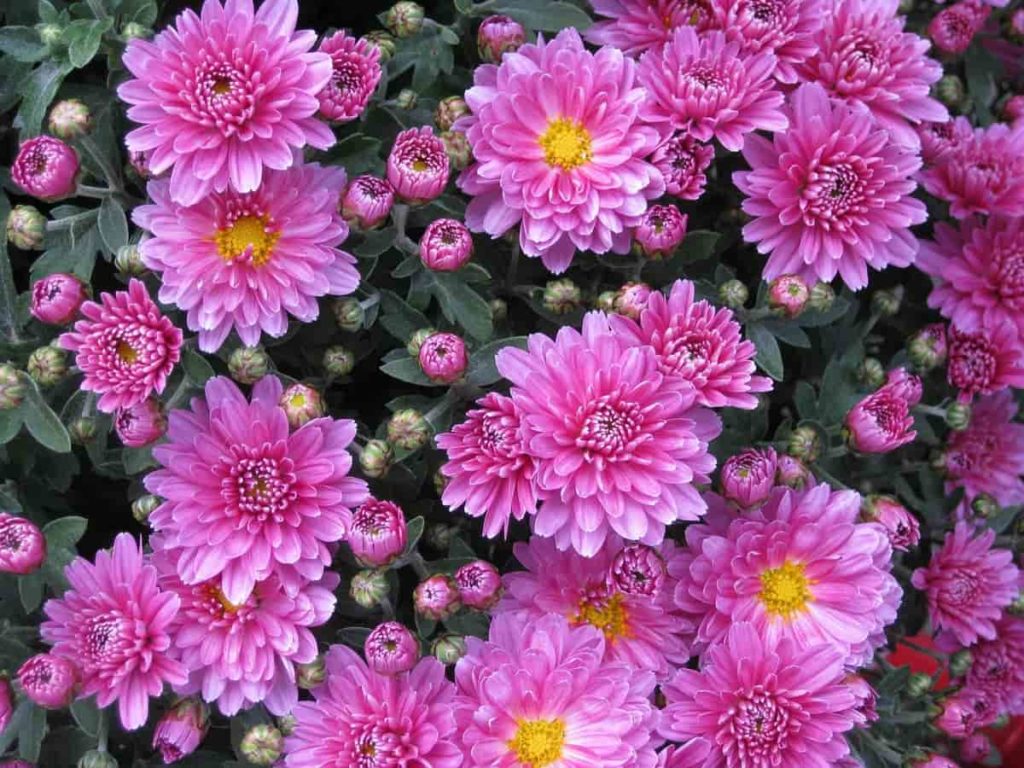
Control release fertilizers/granular fertilizers should be applied by spreading the material around and away from the plant base evenly. Throwing it in one place can create local hot spots. Use a level tablespoon when measuring. Nutrition release depends on temperature and nutritional movement depends on water and rain. Frequent irrigation or rainfall will increase nutritional damage. If the leaching is inadequate, additional soluble salts may occur in hot periods.
When to stop fertilizing Chrysanthemum?
Some plants have started to open and some plants are about to open buds. If you continue fertilizing, the Chrysanthemum buds will open faster than usual and the flowers will also dry long before the end of the opening period. Adding fertilizer to mature plants can also reduce the life of flowers. So, at this stage, do not fertilize the Chrysanthemum plants. This will help the buds to open slowly and the flowers will remain on the branch for a long time without losing their charm.
Frequently asked questions about fertilizers for Chrysanthemum
Why are my Chrysanthemum buds not opening?
Chrysanthemum requires full sun, well-drained soil, and low nitrogen fertilizer to swell. The mums fail to thrive when grown in part shade with highly nitrogen-rich soil.
In case you miss this: DIY Terrace Garden Ideas for Home, How to Start

How do you feed fall Chrysanthemums?
The Chrysanthemum plants in the well-drained soil that gets the full sun. Fertilize well to encourage flowers. If the Chrysanthemum produces spring flowers, pinch them back before the end of summer to encourage falling flowers. Cover the plants with several inches of mulch or straw before winter.
How do you keep Chrysanthemum from opening up very quickly?
The Chrysanthemum must never be permitted to dry during the early stages. Keep plants moist and well-fed until they reach at least 60% of the last size. Avoid planting or moving outside too soon if you fail to maintain maximum temperature.
- How to Grow Hibiscus from Flower
- Plantation Ideas for Home Decoration: A Beginners Guide
- Flower Garden Designs and Layouts for Beginners
- Planting and Spacing Techniques in Papaya: A Beginner’s Guide
- Growing Gold: Essential Techniques for Planting Pineapples
- How to Make Kalanchoe Plant Bushy: Home Remedies and Solutions
- 11 Reasons Why Your Gardenia is Not Blooming: Home Remedies and Solutions
- Eco Elegance: The Guide to Designing a Drought-Tolerant Landscape
- Gardening on a Slope: Strategies for Hillside Landscaping
- Nourish and Flourish: Top Organic Mulches for Thriving House Plants
- Everything You Want to Know about Indian Mogra Flower: Discover Uses and Growing
- Green Thumb Success: Expert Tips for Cultivating Greenhouse Pumpkins All Year Round
- Maximize Growth & Flavor: The Ultimate Guide to Companion Planting in Herb Gardens
- How to Control Rhododendron Problems Naturally: Home Remedies and Organic Ways to Fix Them
- Natural Magic: The Remarkable Benefits of Cinnamon for Plants
- Best Steps to Revive Dying Tulip with Natural and Organic Treatment
- 10 Reasons Why Your Angel Trumpet is Not Blooming: Remedies and Treatment
- How to Fix Periwinkle Leaf and Flower-Related Problems: Natural Remedies and Solutions
- How to Fix Zinnias Leaf and Flower Problems: Discover Natural and Home Remedies
- Organic Steps to Induce Lemon Tree Flowers: A Comprehensive Guide
- Bloom Booster: Crafting the Perfect Homemade Bougainvillea Fertilizer
- Optimizing Growth: A Guide to Applying NPK Fertilizer for Potted Plants
- 10 Best Homemade Fertilizers for Rubber Plant: DIY Recipes and Application Method
- How to Boost Female Pumpkin Flowers: Effective Steps for More Flowers and High Yields
- Transform Your Indoor Garden: Top Benefits of Pink Salt for Houseplants
- 10 Best Homemade Fertilizers for Peacock Plants (Calathea): Easy DIY Guide
- Unlock Blooms: 9 Reasons Why Your Potted Chrysanthemum is Not Blooming
- 8 Reasons Why Your Potted Hibiscus is Not Blooming: Fix it with Simple Solutions
- Unlock Blooms: 9 Key Reasons Your Potted Frangipani Won’t Flower
- 10 Reasons Why Is My Ice Plant Not Blooming: Remedies and Treatment
- 10 Reasons Why My Potted Hydrangea Not Blooming: Treatment and Remedies
- 10 Reasons Why is My Wisteria Not Blooming: Remedies and Treatment
- 10 Reasons Why is My Goldfish Plant Not Blooming: Remedies and Treatment
- Maximize Your Space: Ultimate Guide to Balcony Gardening with Grow Bags
- 10 Reasons Why Your Iris is Not Blooming: Remedies and Treatment
- 10 Reasons Why Your Anthurium Plant is Not Blooming: Treatment and Remedies